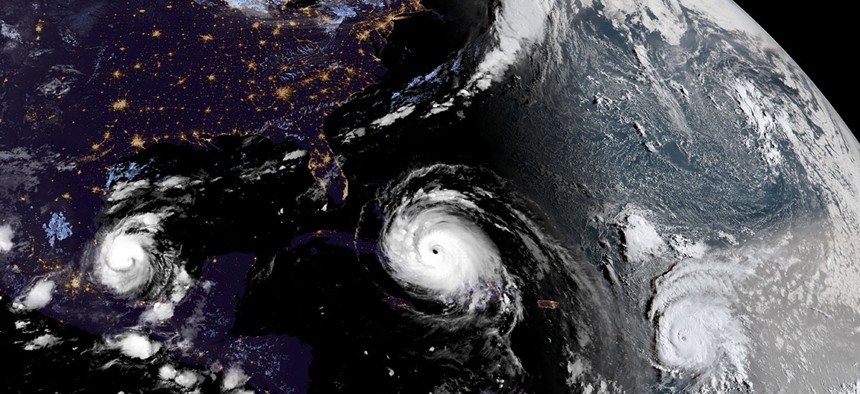U.S. Government’s Hurricane-Hunting Satellite Scheduled to Launch Next Month

In this geocolor image GOES-16 satellite image taken Friday, Sep. 8, 2017, at 10:45 UTC, Hurricane Irma, center, approaches Cuba and Florida, with Hurricane Katia, left, in the Gulf of Mexico, and Hurricane Jose, right, in the Atlantic Ocean. NOAA/AP
NOAA's sending a high-powered replacement into space to boost its weather forecasting capabilities.
The federal government will soon have a new weapon in its hurricane forecasting arsenal.
The National Oceanic and Atmospheric Administration, which includes the National Weather Service, on Wednesday announced a Nov. 10 launch date for the first of its next-generation polar-orbiting satellites, Joint Polar Satellite System-1.
JPSS-1 is the first of a trio of new satellites NOAA, in a partnership with NASA, will build and launch in the coming years. The $10 billion satellite program will replace an aging fleet of satellites with modern technology and cutting-edge instruments.
» Get the best federal technology news and ideas delivered right to your inbox. Sign up here.
“Eighty-five percent of the data flowing into our weather forecast models come from polar-orbiting satellites, such as Suomi NPP and the new JPSS series," said Louis Uccellini, director of NOAA’s National Weather Service. “Using polar satellite data, we have been able to provide emergency managers with more accurate forecasts, allowing them to pre-position equipment and resources days before a storm. JPSS will continue this trend.”
JPSS-1 is the second major environmental satellite to launch in as many years; GOES-16, a geostationary satellite, launched last year and is expected to come online before the year is up.
While geostationary satellites orbit the Earth’s equator at approximately 22,000 miles, polar-orbiting satellites circle the Earth’s poles at a much lower altitude, taking planet-wide measurements 14 times per day from approximately 500 miles above the surface.
The critical data JPSS-1 will collect include atmospheric temperature, moisture levels, sea-surface temperature, ocean color and sea ice cover, and even volcanic ash and fire detection. JPSS-1’s sophisticated instruments, built by contractors including Ball Aerospace, Northrop Grumman, Raytheon and Harris Corp., will provide a massive influx of raw weather data that federal officials say will improve hurricane forecasting.
In the wake of hurricanes Harvey, Irma, Maria and Nate, which devastated portions of the United States, and wildfires that rage on the West Coast, JPSS-1 will provide a wealth of new, high-quality data that could help give forecasters and responders an edge.
“The new JPSS satellite will join GOES-16 as we are confronting one of the most tragic hurricane seasons in the past decade,” said Secretary of Commerce Wilbur Ross, in a statement. “The JPSS satellite system will provide advanced forecasting on not only hurricanes but also dangerous weather events threatening communities across the United States.”
Once launched, JPSS-1 is likely to take about one year before it becomes fully operational, though it could prove somewhat useful to forecasters before that point, as GOES-16 did as Hurricane Harvey formed. In the meantime, NOAA will continue to rely on polar-orbiting satellites that have already outlived their expected lifespans, leading the Government Accountability Office to add the U.S.’ fleet of environmental satellites to its biennial High-Risk List four years ago.
GAO continues to be concerned about a possible gap in quality data should one of the U.S. polar-orbiting satellites fail.
NEXT STORY: Trump's NASA Pivot



